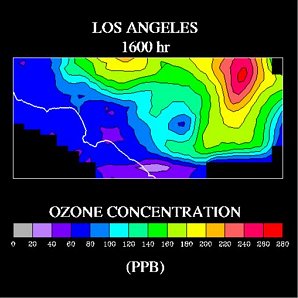





K. Mani Chandy, CRPC Executive Committee Member, Caltech
The primary mission of the CRPC is to make parallel computation truly usable, with the additional goal of preparing future generations for scientific problem-solving. At Caltech and several other sites, we are fulfilling these goals as we work in the area of Problem Solving Environments (PSEs) to make parallel computers easy to use and are bringing this research to students and teachers in universities and the K-12 community.
A PSE is an integrated collection of software tools that is tailored to a specific application area. PSEs enable users to explore scientific or engineering problems in areas as diverse as plasma physics, cosmology, and airshed modeling without being concerned about the details of parallel computing. Internet-based collaboration technologies help distributed groups of people use shared PSEs to solve problems together. Because of this, PSEs are ideal teaching tools as well as facilitators for collaborative research.
Our PSE for airshed modeling, developed by a group led by Donald Dabdub of the University of California at Irvine, enables teachers, students, and concerned citizens to use parallel computing to study air pollution patterns and understand the consequences of public policy on pollution control. The PSE deals with the South Coast Air Basin of California, but is being extended to other regions, and to models at a continental and worldwide scale. The PSE is being used in university courses this year and will be accessible to the K-12 classroom by means of a Web browser or CD-ROMS in late 1998.

|
| This problem solving environment for airshed modeling enables teachers, students, and concerned citizens to use parallel computing to study air pollution patterns in the South Coast Air Basin of California. |
The PSE project has different goals for K-12 and college students. The primary goal for schoolchildren is to show them the importance of science in their daily lives in an immediate and direct way. Science comes alive with tools that help students drive scenarios where they can understand the impact of temperature, wind patterns, automobiles, electric vehicles, biomass, and factories on the air that they breathe. The PSEs guide students as they explore a variety of scenarios.
Schoolchildren will most likely use commodity uniprocessor machines, like Pentium-based PCs or Macintoshes, whereas college students are more likely to have access to parallel supercomputers. The PSE for schoolchildren will use pre-calculated scenarios tailored to their needs. The datasets of the Southern California airshed require several megabytes, and because schools have lower-bandwidth access to the Internet than colleges, we are exploring putting the PSE on CD-ROMs for K-12.
The goal for college students is to introduce them to computational modeling of the environment. College students will be using parallel computers, so the backend of the PSE can execute on a variety of parallel machines. The PSE is being used to teach students at the University of California at Irvine this term, and is being explored for use by Carnegie Mellon University later this year. Other colleges are considering its use for next year. Tom Hewett, professor of psychology at Drexel University, has developed a questionnaire for college students about the use of PSEs. This will provide feedback to the developers and to the National Science Foundation (NSF), the sponsor of the project.
An important part of usability is the development of a variety of interesting scenarios that help students understand the PSE by leading them in a step-by-step process. Textbook material tied to the software will also help usability, but this is a longer-term project. Developing material for education is much more time-consuming and resource-intensive than developing experimental software. It also takes developers who are committed to teaching.
The CRPC is fortunate in its close collaborations with other research projects, such as the NSF-PSE consortium, of which Dabdub is a member. For more information on the PSE project, see http://www.extreme.indiana.edu/pseware/index.html.
 Other Issues of PCR Other Issues of PCR
|
 Back to PCR Back to PCR
|
CRPC Home Page |